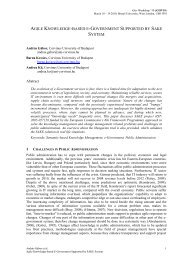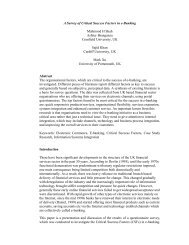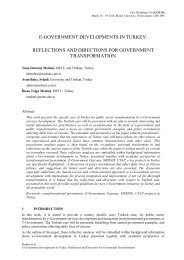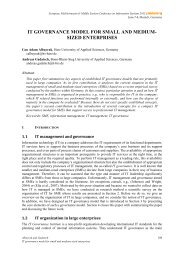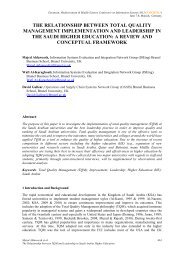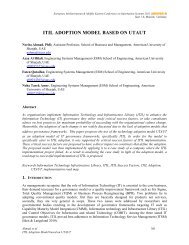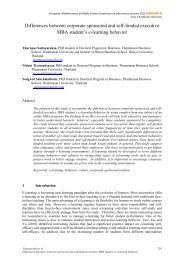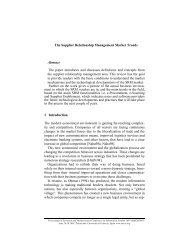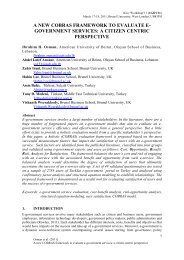Exploiting Customer Relationship Management for Taiwan's ... - ISEing
Exploiting Customer Relationship Management for Taiwan's ... - ISEing
Exploiting Customer Relationship Management for Taiwan's ... - ISEing
You also want an ePaper? Increase the reach of your titles
YUMPU automatically turns print PDFs into web optimized ePapers that Google loves.
equirements (including marketing issues, functionality needed, and the needs from the<br />
company’s IT staff, the marketing manager, the sales or call center employees, and any<br />
other end users), understanding the corporate culture and value disciplines, and applying<br />
the above-mentioned management strategies currently in place and after (CRM<br />
initiative). The CRM team should then determine which competencies, skills, and<br />
technology are needed to deliver the customer and marketing messages effectively and<br />
profitably. A best-of-breed CRM delivers all the customer in<strong>for</strong>mation needed to<br />
achieve greater ROI from IT technology by enriching customer data with attitudes,<br />
awareness, and preferences and then seamlessly integrates it with the overall solution.<br />
For a strategy to be successful, it must be consistent with a bank’s goals and values,<br />
resources and capabilities, structure and systems, and be within the environmental<br />
context of the banking industry. The SWOT (strengths, weakness, opportunities, and<br />
threats) framework is a well-known approach to the design and evaluation of business<br />
strategies. However, it is difficult to distinguish internal strengths from weaknesses and<br />
external opportunities from threats. There<strong>for</strong>e, an approach based on a simple<br />
classification of internal and external factors is better to individuals (domestic banks)<br />
<strong>for</strong> further analysis followed by an appraisal of their implications (Grant, 2002: 15).<br />
Many studies on Taiwan’s banking industry (Chen, 2003; Liu, 2003; NICI, 2004,<br />
2005: 200-202, 254-256; Shive, 2004, 2005; Sung, 2002, Taiwan’s Banking Industry,<br />
2004, 2005) provide a review of the internal and external challenges to CRM<br />
development in Taiwanese banks.<br />
6.1 External Challenges in Taiwan’s Domestic Banks<br />
About 56% and 29% of Taiwan’s domestic banks reported competitive treats from<br />
other financial firms and cross-industry/globalization, higher than that perceived by<br />
<strong>for</strong>eign banks and financial holding companies. The establishment of financial holding<br />
companies locally has boosted integrated operations to a higher peak in Taiwan’s<br />
banking industry. Over 82% perceived that they must expand their service and customer<br />
base via mergers and acquisitions (M&A). This impacts their CRM development in the<br />
enterprise-wide strategy. Foreign banks already exercise customer-centric strategies and<br />
systems integration to streamline the business processes by orchestrating extensive<br />
organizational change. Few domestic banks put <strong>for</strong>th such ef<strong>for</strong>ts in the enterprise-wide<br />
management. They only understand and continuously set service automation at<br />
slow-moving, slow-changing and little risk pace, rather than radical changes by<br />
re-engineering or paradigm shifts with high rewards and substantial chance of failure.<br />
Foreign banks have more advantages than domestic banks in B2B (business to<br />
business) <strong>for</strong> many years. In B2C (business to customer), they intend to almost double<br />
what they did in 2004, but by contrast, domestic banks only hope to keep what they<br />
have done so far. The contrast between the two is remarkable and reveals that <strong>for</strong>eign<br />
banks are more aggressive to customer intimacy.<br />
Forty-seven percent of domestic banks remark their strength is in dense physical<br />
branches, but a study reports that the more physical branches a bank has, the higher its<br />
cost inefficiency is. About 80% and 50% of them have applied <strong>for</strong> Internet banking and<br />
24/7 call center, respectively, under contact channel management and continuously<br />
en<strong>for</strong>ce these functions. Nevertheless, they must integrate both as part of multi-channel<br />
contact management within a CRM architecture based on a respectable (scalable)<br />
customer database and differentiated channels so as to take advantage of cross-selling<br />
and up-selling opportunities that arise during customer service contact. More than 60%<br />
of them have implemented a customer-centric database, but <strong>for</strong>eign banks have put<br />
more richness in customer data management by sophisticated IT applications.<br />
-16



